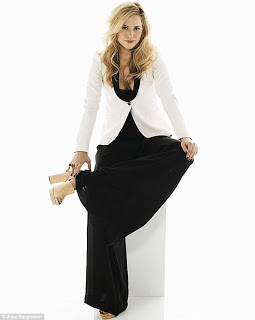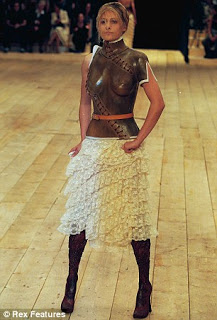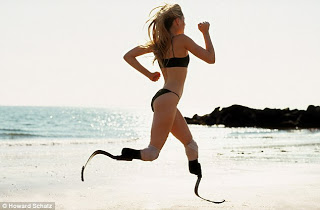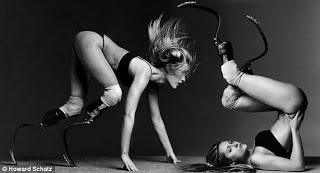MEET THE EXTRAORDINARY AIMEE MULLINS, THE MODEL, ACTRESS & OLYMPIC ATHLETE





Aimee Mullins was born without fibula bones and had her legs amputated below the knee when she was a baby. But far from slowing her down, her ‘difference’ has spurred her on to fulfil her dreams as an actress, model and Olympic athlete
Earlier this year, Aimee was appointed global ambassador to L’Oréal Paris, joining a formidable line-up that embraces Jennifer Lopez, Beyoncé, Eva Longoria and Cheryl Cole. All are highly accomplished, but none has quite the credentials of Aimee.
A former world-class athlete-turned-actress who started her adult life as an intern at the Pentagon, she has packed a phenomenally diverse range of roles into her stellar CV. So much so that you might think modeling is almost beneath her. She begs to differ.
More than 12 years ago, Aimee became a muse for Alexander McQueen. The late designer had spotted her unique difference and proposed an innovative way of celebrating it. Aimee was born without fibula bones in her shins and her legs were amputated just below the knee when she was a year old. McQueen’s idea was to replace her prosthetics with a pair of intricately carved wooden boots. As she strode the catwalk at London Fashion Week, observers assumed that she was simply an intriguing new face. But when news leaked out afterwards, there was a backlash. McQueen was accused of turning his fashion show into a freak show, and Aimee was hailed as ‘the new disabled supermodel’ – a label she loathed. Ever since, her ambition has been to shed the disabled tag. ‘And now it has happened,’ she says. ‘With L’Oréal, I get to be Aimee Mullins, model. No qualifier. And that means everything to me.’
Peachy-skinned, hazel-eyed and blonde, Aimee possesses the natural requisites for promoting beauty products. Visually, she argues, her foreshortened legs are an irrelevance. But she has been hired as much for her personality, and that, she happily concedes, owes much to the silicone limbs that are currently encased in knee-high biker boots and propped on the coffee table before us. ‘It takes some women till their 30s or even 40s to realize that what makes them beautiful is not what makes them the same as everyone else, but what sets them apart,’ she says. ‘I got there earlier. First I had to accept that I wasn’t normal, and then I learned that what I had been told would be a weakness wasn’t. So by my 20s I was able to think, “Thank God I am not normal, because I get to be extraordinary instead.”’
Now 35, Aimee grew up in Allentown, Pennsylvania, the daughter of a factory-worker father and a mother who worked as a hospital receptionist. At birth, no one could explain why Aimee’s legs had not developed properly (the idea was mooted that it could be connected to her mother taking antibiotics before she knew she was pregnant) and doctors told her parents that it was unlikely she would ever walk. Her only hope, they said, was amputating her shins so that she might learn to use prosthetics at the same time that able-bodied children learn to walk normally. The gamble paid off and by the age of two, Aimee was independently mobile, although bone-growth complications meant that she spent the next six years undergoing successive operations.
One of her earliest memories is having to go back into a wheelchair aged five after surgery because her legs were temporarily too swollen for the prosthetics. ‘I was desperate to return to school, but my kindergarten teacher didn’t want me there. She said it was inappropriate and that I would be a distraction for the other pupils.’ Such attitudes are unthinkable today – ‘but, you know, that was only in the 1980s,’ says Aimee.
Spurred on by her two younger brothers, Aimee was a gung-ho girl who swam, rode a bike, climbed trees and skied. She attended a mainstream school and her parents did not seek special treatment for her. ‘To be honest, they had bigger issues on their plate – jobs to do, bills to pay. We were all raised to be self-reliant. I had a paper round and every night I would put the dinner on before Mum came home from work. I was capable because I had to be.’
Inevitably, as a teenager, Aimee was occasionally bullied, but she believes she had no harder a time than her peers: ‘Whether it is your height, your weight or your skin, someone is going to pick on something and make fun of it. My legs were just a more obvious target.’ She remembers lots of outright stares on summer days at the beach. ‘There were times when I would ignore them and times when I would think, “What are you looking at?” But then you realize that if someone is looking down at you, at some point they are also going to look up and engage. I like it now when kids stare at me, because it is a way of starting a dialogue. And it is far better than them not looking at you at all. Nothing is worse than not being seen.’
One of Aimee’s mantras is that she is as much a product of her failures as her accomplishments. ‘We all bullet point our triumphs, but I am who I am because of everything you don’t see on my CV. The stuff that doesn’t work out teaches you how to trust your instincts and adapt.’
It was Aimee’s ‘failure’ to make it as intern that triggered her sporting career. She had always been a team player at school – playing volleyball, football and softball. At Georgetown, she switched her focus to athletics and set her sights on making the US team for the Olympic Games. In 1996 in Atlanta, wearing carbon-fibre prosthetics that were modelled on the hind legs of a cheetah, she set world records for the 100m and 200m sprints, and she still holds the Paralympic amputee record for the long jump. ‘A lot of my life is about will – having the will to prove what my body can do,’ she says. ‘It is such an incredible thing to be able to test yourself to those limits. Being an athlete is something very private that you do in a public way – and acting is similar.’
Aimee wanted to be an actress ‘for as long as I can remember’. She has had some marked successes, most notably in Cremaster 3, an art-house film directed by Matthew Barney, partner of Icelandic singer Björk. But she still does not consider her acting career fully fledged. ‘I’ve started it – I remember flying to London to appear in a Poirot film and thinking, “OK, I am officially getting paid to be an actor, so I can call myself an actor now.” It is such a loaded thing – especially if you go to Los Angeles, where everyone from the person doing your nails to the garage attendant is an actor.’ Aimee lives in New York and I get the impression that LA is not her favourite place. ‘New York and London are much more me. They are places where you are allowed to be who you are.’
She credits Alexander McQueen with helping her to appreciate British eccentricity. Inevitably, she was deeply saddened by his death last year: ‘I got him completely and he got me.’ Many years ago, she also met Heather Mills, who, as a fellow amputee, introduced her to her Bournemouth-based prosthetist Bob Watts, who has also been prosthetist to the British Paralympic team. He was able to replace Aimee’s plastic legs with the silicone limbs that come complete with hair follicles and freckles. ‘He’s the best in the world. My prosthetics are so lifelike no one can believe they’re not real.’ She has five pairs, built at different heel heights. ‘Like anyone, I am more comfortable in flats – but sometimes, we all need a heel, right? The highest ones are an inch longer in the leg, because why not have some fun with them?’
Aimee’s contract with L’Oréal has enabled her to realize a dream, but she doesn’t anticipate extending her modeling career. ‘I can’t do that clothes-hanger thing. But then the reason I’m here is because I haven’t played by the rules. We need the clothes-hanger models, but they are not the ones that you remember.’
The ambassadorial role does mean her life will become more peripatetic than ever, with publicity and speaking engagements around the world. I wonder where this leaves her personal life, but she doesn’t want to discuss her relationship status, so I assume the answer is inconclusive.
- HOW TO DRESS LIKE PARISIAN WOMEN: ACHIEVING EFFORTLESS CHIC - August 14, 2024
- THE BRAVE ADVENTURE OF JOSH THE GREAT: A FAITH-FILLED JOURNEY OF COURAGE AND FORGIVENESS - August 14, 2024
- FASHION AND BEAUTY ICONS FROM AROUND THE WORLD - July 28, 2024



